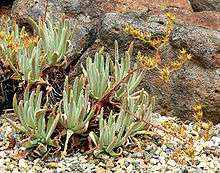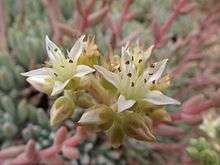Dudleya virens
Dudleya virens, the green liveforever or bright green dudleya, is an uncommon species of perennial, succulent plant in the family Crassulaceae, native to several coastal southern California and Baja California locations.[2]
| Dudleya virens | |
|---|---|
 | |
| Dudleya virens ssp. hassei | |
| Scientific classification | |
| Kingdom: | Plantae |
| Clade: | Tracheophytes |
| Clade: | Angiosperms |
| Clade: | Eudicots |
| Order: | Saxifragales |
| Family: | Crassulaceae |
| Genus: | Dudleya |
| Species: | D. virens |
| Binomial name | |
| Dudleya virens | |
| Synonyms[1] | |
| |
.jpg)

Distribution
The succulent is found growing in the Palos Verdes Hills on the Palos Verdes Peninsula coast in Los Angeles County; on several of the Channel Islands in California; and on Guadalupe Island off the northwestern Baja California Peninsula, Mexico.
Description
Dudleya virens leaves are fleshy and strap-shaped, 8–20 cm long and 1.5–3 cm broad, tapering from the base (or from near middle) and are mostly green. They are arranged in a rosette.
The flowers are white, with five petals 7–10 mm long; they are produced in April, May, and June. Hummingbirds visit the flowers for their nectar.
Subspecies
Subspecies include:
- Dudleya virens subsp extima — endemic to Guadalupe Island, Baja California.[3]
- Dudleya virens subsp. hassei — endemic to Catalina Island, California.[4]
- Dudleya virens subsp. insularis — Catalina Island, San Nicolas Island, Palos Verdes Hills; endemic to California.[5]
- Dudleya virens subsp. virens — Catalina Island, San Clemente Island, Palos Verdes Hills; endemic to California.[6]
Cultivation
Dudleya virens is cultivated as an ornamental plant in the specialty native plants and succulents horticulture trade.[7] It is used in containers, drought tolerant landscapes, and habitat gardens. It prefers well-draining soil, and grows best in full sun or light shade.
References
- The Plant List: A Working List of All Plant Species, retrieved 9 July 2016
- Calflora Database: Dudleya virens . accessed 6.30.2013
- Crassulaceae.com: Dudleya virens ssp. extima Archived December 18, 2013, at the Wayback Machine
- Calflora Database: Dudleya virens ssp. hassei
- Calflora Database: Dudleya virens ssp. insularis
- Calflora Database: Dudleya virens ssp. virens
- Rancho Santa Ana Botanic Garden: Native Plants for Coastal Gardens . accessed 6.30.2013
External links
| Wikimedia Commons has media related to Dudleya virens. |